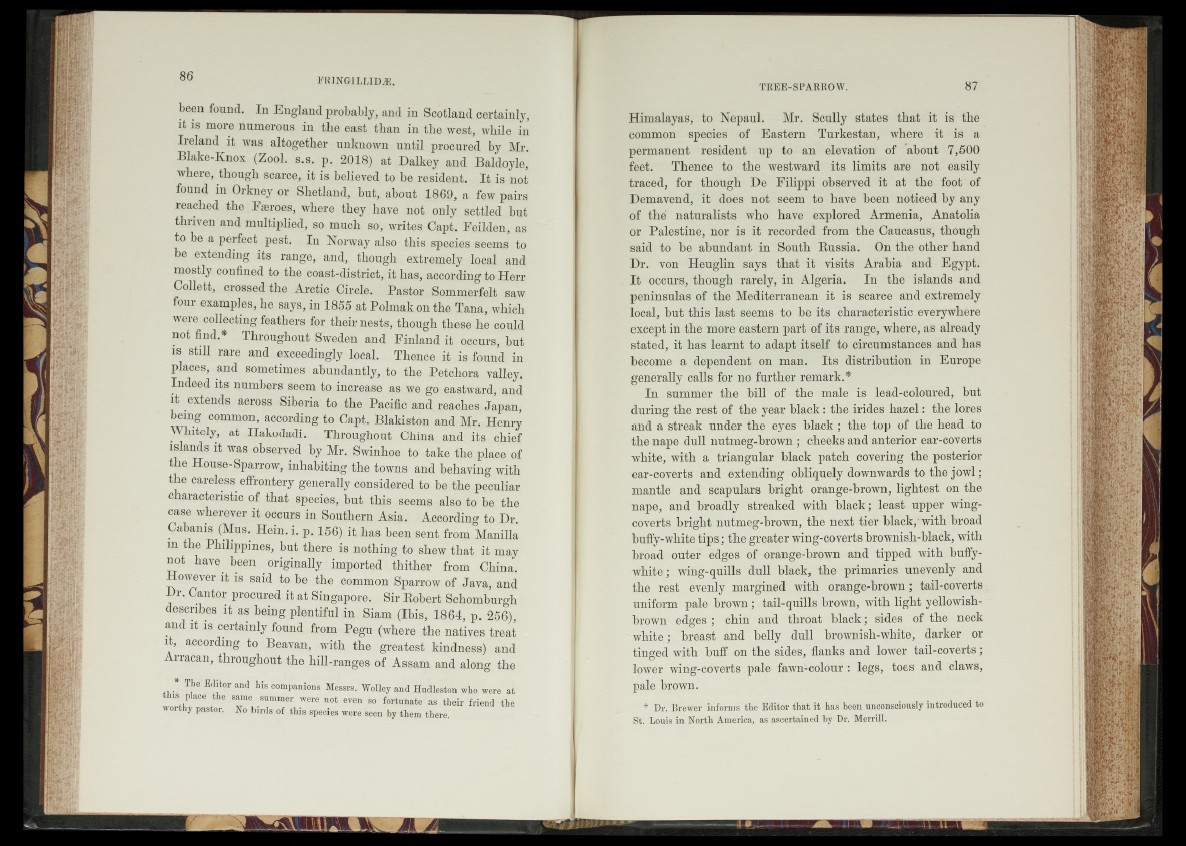
been found. In England probably, and in Scotland certainly,
it is more numerous in tbe east than in the west, while in
Ii eland it was altogether unknown until procured by Mr.
Blake-Knox (Zool. s.s. p. 2018) at Dalkey and Baldoyle,’
where, though scarce, it is believed to be resident. It is not
found in Orkney or Shetland, but, about 1869, a few pairs
reached the Faeroes, where they have not only settled but
thriven and multiplied, so much so, writes Capt. Feilden, as
to be a perfect pest. In Norway also this species seems to
be extending its range, and, though extremely local and
mostly confined to the coast-district, it has, according to Herr
Collett, crossed the Arctic Circle. Pastor Sommerfelt saw
four examples, he says, in 1855 at Polmak on the Tana, which
were collecting feathers for their nests, though these he could
not find.* Throughout Sweden and Finland it occurs, but
is still rare and exceedingly local. Thence it is found in
places, and sometimes abundantly, to the Petchora valley.
Indeed its numbers seem to increase as we go eastward, and
it extends across Siberia to the Pacific and reaches Japan,
being common, according to Capt. Blakiston and Mr. Henry
Whitely, at Hakodadi. Throughout China and its chief
islands it was observed by Mr. Swinhoe to take the place of
the House-Sparrow, inhabiting the towns and behaving with
the careless effrontery generally considered to be the peculiar
characteristic of that species, but this seems also to be the
case wherever it occurs in Southern Asia. According to Dr
Cabanis (Mus. Hein. i. p. 156) it has been sent from Manilla
m the Philippines, but there is nothing to shew that it may
not have been originally imported thither from China.
However it is said to be the common Sparrow of Java, and
Dr. Cantor procured it at Singapore. Sir Robert Schomburgh
describes it as being plentiful in Siam (Ibis, 1864, p. 256),
and it is certainly found from Pegu (where the natives treat
it, according to Beavan, with the greatest kindness) and
Arracan, throughout the hill-ranges of Assam and along the
* The Editor and his companions Messrs. Wolley and Hudleston who were at
his place the same summer were not even so fortunate as their friend the
worthy pastor. No birds of this species were seen by them there.
Himalayas, to Nepaul. Mr. Scully states that it is the
common species of Eastern Turkestan, where it is a
permanent resident up to an elevation of about 7,500
feet. Thence to the westward its limits are not easily
traced, for though De Filippi observed it at the foot of
Demavend, it does not seem to have been noticed by any
of thé naturalists who have explored Armenia, Anatolia
or Palestine, nor is it recorded from the Caucasus, though
said to be abundant in South Russia. On the other hand
Dr. von Heuglin says that it visits Arabia and Egypt.
It occurs, though rarely, in Algeria. In the islands and
peninsulas of the Mediterranean it is scarce and extremely
local, but this last seems to be its characteristic everywhere
except in the more eastern part of its range, where, as already
stated, it has learnt to adapt itself to circumstances and has
become a dependent on man. Its distribution in Europe
generally calls for no further remark.*
In summer the bill of the male is lead-coloured, but
during the rest of the year black: the irides hazel: the lores
and a streak under the eyes black; the top of the head to
the nape dull nutmeg-brown ; cheeks and anterior ear-coverts
white, with a triangular black patch covering the posterior
ear-coverts and extending obliquely downwards to the jowl;
mantle and scapulars bright orange-brown, lightest on the
nape, and broadly streaked with black; least upper wing-
coverts bright nutmeg-brown, the next tier black,-with broad
buffy-white tips; the greater wing-coverts brownish-black, with
broad outer edges of orange-brown and tipped with buffy-
white; wing-quills dull black, the primaries unevenly and
the rest evenly margined with orange-brown; tail-coverts
uniform pale brown; tail-quills brown, with light yellowish-
brown edges ; chin and throat black; sides of the neck
white; breast and belly dull brownish-white, darker or
tinged with buff on the sides, flanks and lower tail-coverts;
lower wing-coverts pale fawn-colour : legs, toes and claws,
pale brown.
* Dr. Brewer informs the Editor that it has been unconsciously introduced to
St. Louis in North America, as ascertained by Dr. Merrill.